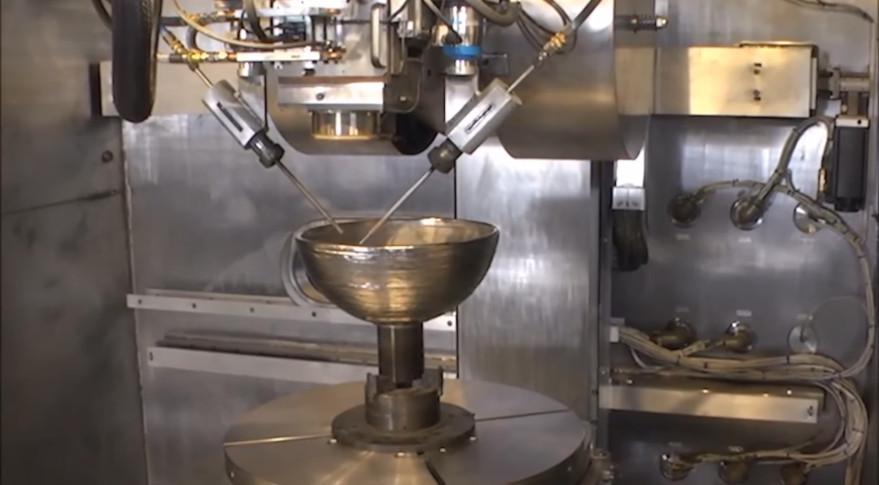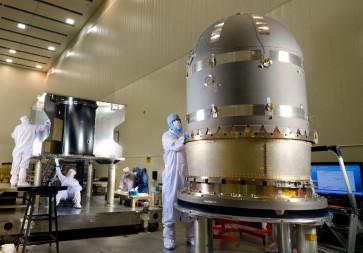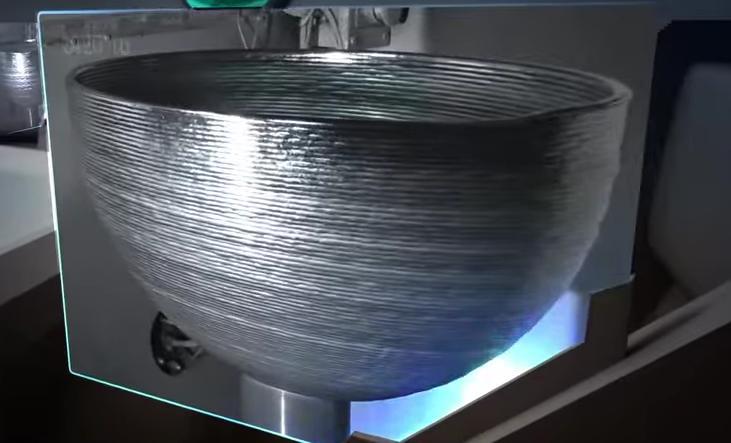 In the Sciaky additive manufacturing process, the hemispherical halves of tanks are built layer by layer as spools of titanium wire spin and provide material. As a result of using the process, Lockheed Martin Space Systems says they plan to re-think the way they make satellite propellant tanks, and they’ll eventually move the construction of those tanks in-house–and save money in the bargain.
In the Sciaky additive manufacturing process, the hemispherical halves of tanks are built layer by layer as spools of titanium wire spin and provide material. As a result of using the process, Lockheed Martin Space Systems says they plan to re-think the way they make satellite propellant tanks, and they’ll eventually move the construction of those tanks in-house–and save money in the bargain.
 At this point, Lockheed Martin buys those critical titanium tanks from Orbital ATK. The three Mars orbiters use the Orbital ATK tanks as will NASA’s OSIRIS-Rex asteroid-probing space vehicle upon its completion and launch in 2016 launch.
At this point, Lockheed Martin buys those critical titanium tanks from Orbital ATK. The three Mars orbiters use the Orbital ATK tanks as will NASA’s OSIRIS-Rex asteroid-probing space vehicle upon its completion and launch in 2016 launch.
Mike Hamel, vice president and general manager for Lockheed Martin, says that may well change if the additive manufacturing methods the company is testing are satisfactory.
“We may switch to additive manufacturing later,” Hamel says.
Much of the effort behind moving toward AM techniques at Lockheed Martin is the work of Rick Ambrose, the company’s executive vice president for space systems. Ambrose says it’s become critical to reduce the lead times for building satellites, and he says 3D printing holds the keys to reaching that goal.
The $4 million 3D printing machine Lockheed bought last year from Sciaky Inc. is capable of turning out fuel tanks of nearly 150 centimeters in diameter and the method can cut the cost of manufacturing propellent tanks by as much as half.
The process is also much speedier than casting those tanks in molds. When the lead time of the casting technique is included–around 20 months–and the time spent procuring the bulk, forged  titanium billets is factored in, additive manufacturing is considerably quicker.
titanium billets is factored in, additive manufacturing is considerably quicker.
“Manufacturers, for the first time, will be able to utilize Sciaky’s revolutionary additive manufacturing technology to produce production parts and prototypes in their own facility. The possibilities are endless,” says Mike Riesen, the general manager of Sciaky.
Material costs can be cut in relation to structural titanium parts that are machined from a billet or forged. Riesen adds that the process can also time spent machining parts by as much as 80%. According to Dennis Little, Lockheed’s vice president of production for space systems, those manufacturing advantages mean 3D printed titanium tanks will be in use on spacecraft before the decade is out if an internal evaluation of the process meets certification criteria from NASA and the Air Force.
Little also says similar tanks will be in use on commercial, military, and civil satellites “within the next couple of years.”
Do you know of any aerospace manufacturers already using additive processes to build their products? Let us know in the Lockheed Martin forum thread on 3DPB.com.
Subscribe to Our Email Newsletter
Stay up-to-date on all the latest news from the 3D printing industry and receive information and offers from third party vendors.
Print Services
Upload your 3D Models and get them printed quickly and efficiently.
You May Also Like
Reinventing Reindustrialization: Why NAVWAR Project Manager Spencer Koroly Invented a Made-in-America 3D Printer
It has become virtually impossible to regularly follow additive manufacturing (AM) industry news and not stumble across the term “defense industrial base” (DIB), a concept encompassing all the many diverse...
Inside The Barnes Global Advisors’ Vision for a Stronger AM Ecosystem
As additive manufacturing (AM) continues to revolutionize the industrial landscape, Pittsburgh-based consultancy The Barnes Global Advisors (TBGA) is helping shape what that future looks like. As the largest independent AM...
Ruggedized: How USMC Innovation Officer Matt Pine Navigates 3D Printing in the Military
Disclaimer: Matt Pine’s views are not the views of the Department of Defense nor the U.S. Marine Corps Throughout this decade thus far, the military’s adoption of additive manufacturing (AM)...
U.S. Congress Calls Out 3D Printing in Proposal for Commercial Reserve Manufacturing Network
Last week, the U.S. House of Representatives’ Appropriations Committee moved the FY 2026 defense bill forward to the House floor. Included in the legislation is a $131 million proposal for...

































